Christian Symbols
 |
Fish: the
fish -- ever-watchful with its unblinking eyes -- was one of the most important
symbols of Christ to the early Christians. In Greek, the phrase, "Jesus Christ,
Son of God Savior," is "Iesous Christos Theou Yios Soter." The first letters
of each of these Greek words, when put together, spell "ichthys," the Greek
word for "fish" (ICQUS ). This symbol can
be seen in the
 Sacraments
Chapel of the Catacombs of St. Callistus. Because of the story of the miracle
of the loaves and fishes, the fish symbolized, too, the Eucharist (see stylized
fish symbol at right). Sacraments
Chapel of the Catacombs of St. Callistus. Because of the story of the miracle
of the loaves and fishes, the fish symbolized, too, the Eucharist (see stylized
fish symbol at right).
The earliest literary reference to the fish as Christian symbol was made
by Clement of Alexandria, who advised Christians to use a dove or fish as
their seal. Tertullian wrote (in "De Baptismo") "But we, being little fishes,
as Jesus Christ is our great Fish, begin our life in the water, and only
while we abide in the water are we safe and sound." Also used as a Christian
symbol was the dolphin, most often as a symbol of the Christian himself rather
than Christ, though the dolphin was also used as a representation of Christ
-- most often in combination with the anchor symbol ("Christ on the
Cross"). |
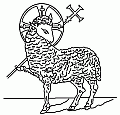 |
Lamb:
symbol of Christ as the Paschal Lamb and also a symbol for Christians
(as Christ is our Shepherd and Peter was told to feed His sheep). The lamb
is also a symbol for St. Agnes (Feast Day 21 January), virgin martyr of the
early Church. |
 |
Dove:
symbol of the Holy Ghost and used especially in representations of our Lord's
Baptism and the Pentecost. It also symbolizes the release of the soul in
death, and is used to recall Noe's dove, a harbinger of hope. |
 |
Peacock:
As a symbol of immortality (even St. Augustine believed the peackock's
flesh to have "antiseptic qualities" and that it didn't corrupt), the peacock
became a symbol of Christ and the Resurrection. Its image embellished everything
from the Catacombs to everyday objects, like lamps, especially in early
Romanesque and Byzantine churches. (The peacock, for obvious reasons, was
also used as a symbol for pride, too) |
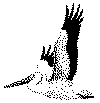 |
Pelican:
The Pelican is a symbol of the atonement and the Redeemer and is often
found in Christian murals, frescos, paintings and stained glass. The pelican
was believed to wound itself in order to feed its young with its own blood.
In the hymn "Adoro Te," St. Thomas Aquinas addresses the Savior with, "Pelican
of Mercy, cleanse me in Thy Precious Blood." Allusion is even made to this
belief in "Hamlet" (act iv): "To his good friend thus wide I'll ope my arms
And, like the kind, life-rendering pelican, Repast them with my blood." |
 |
Phoenix:
The Phoenix is a mythical creature said to build a nest when old, and
set it on fire. It would then rise from the ashes in victory. Because of
these myths (believed by the Egyptians, Greeks, and Orientals), the bird
came to symbolize Christ. |
 |
Ship: As
those outside of Noe's Ark were destroyed, the ship became a perfect early
symbol of the Church with its associations with "the barque of Peter, the
Fisherman." In the same vein, the main part of a church's interior, the place
where the people worship, is called a "nave," from the Latin "navis" -- ship.
The Ark is also a symbol of the Temple through its shape and purpose, both
having three levels, etc. And as a symbol of the Temple and Church, it is
a symbol of Mary, sealed off with pitch and closed up by God Himself. |
 |
Rainbow:
Sign of the Covenant with Noe. Its 7 colors (from the top down: red,
orange, yellow, green, blue, indigo, and violet) recall the 7 Sacraments
(7 is the sign of Covenant and completion). In St. John's vision of Heaven,
a rainbow makes an appearance -- over the head of the angel who gives John
a book to eat (ch. 10), and surroudning the throne of God:
Apocalypse 4:2-3
2
And immediately I was in the spirit: and behold there was a throne set in
heaven, and upon the throne one sitting. And he that sat, was to the sight
like the jasper and the sardine stone; and there was a rainbow round about
the throne, in sight like unto an emerald.
|
 |
The Good
Shepherd: Some of the earliest depictions of Christ show Him as the Good
Shepherd. This type of representation is found in the Catacombs.
Click to see a picture of The
Good Shepherd from the Priscilla Catacombs, and
here to see a statue of the Good
Shepherd, dated ca. A.D. 225 (will open in new browser windows). |
 |
Palm:
victory and martyrdom. Palms are especially made use of on Palm Sunday.
The ashes of palms used on Palm Sunday are later burned and used on the next
year's Ash Wednesday to symbolize mortality and penance. |
 |
Scallop
shell: the sea shell, especially the scallop shell, is the symbol of
Baptism, and is found frequently on Baptismal fonts. The dish used by priests
to pour water over the heads of catechumens in Baptism is often scallop-shaped.
The scallop, too, is a symbol for the Apostle James the Greater. |
 |
Butterfly:
The beautiful butterfly, with the power of flight, emerging from the
apparently lifeless cocoon: what could be a more perfect symbol of the
Resurrection? |
 |
Unicorn:
the unicorn -- mentioned in the Bible, by the way: see Psalm 21:22, 28:6
(Psalms 22 and 29 in the King James Bible), 92:11; and Isaias 34:7 -- is
a symbol of chastity and of Christ Himself. Medieval legend had it that the
unicorn, a feisty and fierce animal, could not be easily hunted, but if a
virgin were to sit in the forest, the unicorn would find her and lay its
head upon her lap. The hunter could then come by and take its horn, which
was seen as having profound medical qualities (for ex., it was said to eliminate
the harmful effects of a poisoned liquid). The picturing of a virgin and
unicorn together, then, was common during the Age of Faith -- the former
representing Our Lady, and the latter representing Christ, Who brought forth
the "horn of salvation." |
 |
Ermine:
the ermine was believed to have rather died than get its pure white coat
dirty and, so, it came to symbolize innocence, moral purity, and the Christian's
desire to die rather than commit a mortal sin. Its fur was used to adorn
the clothes of clerics and royalty. |
 |
Elephant:
the male and female elephant together represent Adam and Eve |
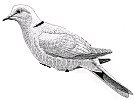 |
Turtledove:
because of their reputation for taking only one mate to whom they are
faithful for life, turtledoves are a symbol of Christian fidelity. They are
also known for their love of seclusion, a fact mentioned by St. Augustine
(City of God, Book 16, chapter 24). |
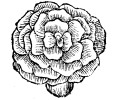 |
Rose: the
Holy Faith, Our Lady, martyrdom, the secrecy of
penance. Five roses grouped together symbolize
the 5 Wounds of Christ. |
 |
Scarab:
an ancient symbol of regeneration (the scarab was an especially prevalent
symbol in Egypt), the scarab was adopted by Christians, too, as a symbol
for the same and for the Resurrection, in particular, and for Christ Himself.
Habacuc 2:11 was often translated as "For the stone shall cry out of the
wall, and the beetle out of the timber shall answer it." Psalm 21:7's mention
of "worm" ("But I am a worm, and no man: the reproach of men, and the outcast
of the people") was often translated as "scarab," and St. Ambrose, Bishop
of Milan (A.D. 340-397) referred to Christ as “The Good Scarabaeus”
numerous times, with other Church Fathers, such as SS. Cyril of Alexandria,
Augustine, etc.) following suit. |
 |
Owl:
the owl has a double meaning: 1) the perfidious Jews who, preferring darkness
to light, reject Jesus, and 2) (from the Aberdeen Bestiary), "In a mystic
sense, the night-owl signifies Christ. Christ loves the darkness of night
because he does not want sinners - who are represented by darkness - to die
but to be converted and live... The night-owl lives in the cracks in walls,
as Christ wished to be born one of the Jewish people, saying: 'I am not sent
but unto the lost sheep of the house of Israel'. But Christ is crushed in
the cracks of the walls, because he is killed by the Jews. Christ shuns the
light in the sense that he detests and hates vainglory... The night-owl flies
at night in search of food, as Christ converts sinners into the body of the
Church by preaching. In a moral sense, moreover, the night-owl signifies
to us not just any righteous man, but rather one who lives among other men
yet hides from their view as much as possible. He flees from the light, in
the sense that he does not look for the glory of human praise." |
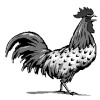 |
Cock: the
cock is the harbinger of the dawn, and "Oriens" -- "Dawn" -- is one of the
titles for Christ (used especially in the O Antiphons during Advent). It
is, then, a general symbol for Hope. Further, it is ancient belief that the
cock's crow breaks enchantments and evil spells. Prudentius (d. 861), Bishop
of Troyes, wrote "They say that the night-wandering demons, who rejoice in
dunnest shades, at the crowing of the cock tremble and scatter in sore affright."
The Aberdeen Bestiary (c. 1200) speaks of the cock thusly:
The crowing of
the cock at night is a pleasant sound, and not only pleasant but useful;
like a good partner, the cock wakes you when are asleep, encourages you if
you are worried, comforts you if you are on the road, marking with its melodious
call the progress of the night.
With the crowing of the cock, the robber calls off his ambush; the morning
star itself is awakened, rises and lights up the sky; the anxious sailor
sets aside his cares, and very often each tempest and storm whipped up by
evening winds moderates. At cockcrow the devout of mind rise eagerly to pray,
able once again to read the office. When the cock crowed assiduously for
the last time, Peter himself, the rock of the Church, washed away his guilt,
which he had incurred by denying Christ before cockcrow.
With the crowing of the cock, as with the words of Jesus, hope returns to
everyone, the troubles of the sick are eased, the pain of wounds is lessened,
the raging heat of fevers is moderated, faith is restored to those who have
fallen. Jesus watches over those who falter, he corrects those who stray;
in short, he looked at Peter and immediately his sin went away, his denial
was put out of mind, his confession followed.
The Winter Hymn
of Sunday's Lauds include this hymn from St. Ambrose (d. 397):
Light of our darksome
journey here,
With days dividing night from night!
Loud crows the dawn's shrill harbinger,
And wakens up the sunbeams bright.
Forthwith at this, the darkness chill
Retreats before the star of morn;
And from their busy schemes of ill
The vagrant crews of night return.
Fresh hope, at this, the sailor cheers;
The waves their stormy strife allay;
The Church's Rock at this, in tears,
Hastens to wash his guilt away.
Arise ye, then, with one accord!
No longer wrapt in slumber lie;
The cock rebukes all who their Lord
By sloth neglect, by sin deny.
At his clear cry joy springs afresh;
Health courses through the sick man's veins;
The danger glides into its sheath;
The fallen soul her faith regains.
|
 |
Trefoil:
a stylized shamrock, such as St. Patrick used in evangelizing Ireland,
the trefoil is a symbol of the Most Holy Trinity. |
 |
Quatrefoil:
ubiquitous in Gothic architecture, the quatrefoil symbolizes the four
evangelists, as do the Winged Man (Matthew), Lion (Mark), Ox (Luke), and
Eagle (John) -- the four beasts of Ezeckiel and the Apocalypse. |
 |
3 Nails:
3 nails symbolize the Crucifixion. They are three in number because two
nails were used to secure Christ's Hands, and a third was used to secure
His Feet. The 3 nails are often combined with other symbols, such as they
are in the Jesuit seal -- the letters IHS with the three nails underneath,
all surmounted by a Cross. |
 |
Anchor:
found in the first century cemetery of St. Domitilla, the second and third
century epitaphs of the catacombs, and especially in the oldest parts of
the cemeteries of Sts. Priscilla (about 70 examples in this cemetery alone),
Domitilla, Calixtus, and the Coemetarium majus. See Hebrews 6:19. |
 |
Egg:
the egg is a wonderful symbol of birth and rebirth, an apparently lifeless
object out of which comes life. Because of this, it is a symbol of Christ's
Resurrection and is seen most often at Easter. In 2006, a necropolis under
the Vatican revealed an infant who'd been buried holding an egg to symbolize
his parents' hope in his resurrection, because of Christ's Resurrection.
Legend has it that St. Mary Magdalen went to Rome and met with the Emperor
Tiberius to tell him about the Resurrection of Jesus. She held out an egg
to him as a symbol of this, and he scoffed, saying that a man could no more
rise from the dead than that egg that she held could turn scarlet. The egg
turned deep red in her hands, and this is the origin of Easter eggs, and
the reason why Mary Magdalen is often portrayed holding a scarlet egg.
Another level of symbolism is that the egg represents the Creation, the elements,
and the world itself, with the shell representing the firmament, the vault
of the sky where the fiery stars lie; the thin membrane symbolizing air;
the white symbolizing the waters; and the yolk representing earth. |
 |
Keys: The
Keys are the symbol of the authority of the papacy and the Church's power
to "bind and loose" (Matthew 16:19 and Isaiah 22). |
 |
"Chi-Rho"
or "sigla": the letters "X" and "P," representing the first letters of
the title "Christos," were eventually put together to form this symbol for
Christ ("Chi" is pronounced "Kie"). It is this form of the Cross that Constantine
saw in his vision along with the Greek words, TOUTO NIKA, which are rendered
in Latin as "In hoc signo vinces" and which mean "in this sign thou shalt
conquer. |
 |
Alpha-Omega:
Alpha, the first letter of the Greek alphabet, and Omega, the last letter
of the Greek alphabet, became a symbol for Christ due to His being called
"the First and the Last." The roots of symbolizing these attributes of God
go back further, all the way to the Old Testament where, in Exodus 34:6,
God is said to be "full of Goodness and Truth." The Hebrew spelling of the
word "Truth" consists of the 3 letters "Aleph," "Mem," and "Thaw" -- and
because "Aleph" and "Thaw" are the first and last letters of the Hebrew alphabet,
the ancients saw mystical relevance in God's being referred to as "Truth."
At any rate, the Greek Alpha and Omega as a symbol for Christ has been found
in the Catacombs, Christian signet rings, post-Constantine coins, and the
frescoes and mosaics of ancient churches. |
 |
IHS:
dating from the 8th c., this is an abbreviation for "IHESUS," the way
Christ's Name was spelled in the Middle Ages (despite popular belief, the
monogram stands neither for "Iesus Hominum Salvator" --"Jesus Saviour of
Men" -- nor for "In His Service.") Popularized by St. Bernardine of Siena,
the monogram was later used by St. Ignatius of Loyola as a symbol for the
Jesuit Order. |
 |
"Crux commissa"
or "thau" or "tau": the T-shaped cross is mentioned in the Old Testament
and is seen as a foreshadowing of the Cross of Christ. Ezechiel 9:4:
And the Lord said
to him: Go through the midst of the city, through the midst of Jerusalem:
and mark Thau upon the foreheads of the men that sigh, and mourn for all
the abominations that are committed in the midst thereof.
The Thau of Ezechiel
was itself presaged by the image of Moses's brazen serpent that he held up
on a pole in Numbers 21:
And the Lord said
to him: Make brazen serpent, and set it up for a sign: whosoever being struck
[by the "fiery serpents"] shall look on it, shall live. Moses therefore made
a brazen serpent, and set it up for a sign: which when they that were bitten
looked upon, they were healed.
Because of these
verses, at least one of the ancients believed the Thau to be the form of
the Cross of Jesus. Tertullian wrote, "The Greek letter and our Latin letter
T are the true form of the cross, which, according to the Prophet, will be
imprinted on our foreheads in the true Jerusalem." (Contra Marc., III, xxii)
If "Thau" was the true form of the Cross, the existence of the titulus crucis
(the plaque that bore the inscription "Jesus of Nazareth, King of the Jews")
would have made the Cross at least appear to be a "crux immissa" (see below),
and there would have had to have been enough of the upright post over the
arms on which to affix it. Nonetheless, whether the "immissa" or commissa"
was the true form of the Cross, at the very least the Thau depicts the Cross
of Christ symbolically, and St. Francis of Assisi took the Thau as the symbol
of his Franciscan Order. |
 |
"Crux immissa"
or "Latin Cross": the most common form of the Cross and believed to be
of the style on which Jesus died. |
 |
Byzantine
Cross: used mostly by the Eastern Catholic and Eastern Orthodox Churches.
The second cross-bar at top is for the INRI inscription; the bottom cross-bar
is His footrest. |
 |
Slavonic
Cross: used most often by Eastern Catholics and Russian Orthodox, this
Cross is the Byzantine Cross with the footrest at a diagonal. This slant
is said to represent one of a few things:
-
the footrest wrenched
loose from the Christ's writhing in intense physical suffering; lower side
representing "down," the fate of sinners, while the elevated side represents
Heaven;
-
the lower side
represents the bad thief (known to us as Gestas through the apocryphal "Acts
of Pilate" ("Gospel of Nicodemus") while the elevated side to Christ's right
represents the thief who would be with Him in Paradise (St. Dismas);
-
the "X" shape of
the slanted "footrest" against the post symbolizes the cross on which St.
Andrew was crucified.
|
 |
Greek
Cross: a very common artistic representation of the Cross. Crosses such
as this one and the Tau were also popular because they were easily disguised,
an important feature for persecuted Christians. |
 |
Jerusalem
Cross: also called the "Crusaders' Cross," it is made up of 5 Greek Crosses
which are said to symbolize a)
 the 5 Wounds of Christ; and/or b) the 4 Gospels and the 4 corners
of the earth (the 4 smaller crosses) and Christ Himself (the large Cross).
This Cross was a common symbol used during the wars against Islamic aggression.
(see less stylized version at right) the 5 Wounds of Christ; and/or b) the 4 Gospels and the 4 corners
of the earth (the 4 smaller crosses) and Christ Himself (the large Cross).
This Cross was a common symbol used during the wars against Islamic aggression.
(see less stylized version at right) |
 |
Maltese
Cross: associated with the Knights of St. John (also known as the
"Hospitallers of St. John of Jerusalem" or simply "Knights of Malta"), this
Cross's 8 points are said to symbolize the 8 Beatitudes and the Beatitudes'
associated obligations. The Order of St. John ran hostels and hospitals for
Christian pilgrims to Jerusalem, but eventually had to fight during the wars
of Islamic aggression. It is said that the Maltese Cross is a symbol within
a symbol in that it is made of the initial letters of the Greek words for,
"Jesus Christ, God, Son, Savior" ("Iesous Christos Theou Huios Soter"), which
forms the acrostic for the word "fish" (see "fish" above). When these letters
-- ICQUS -- (Iota, Chi, Theta, Upsilon,
Sigma) are stacked on top of each other and their "ends" closed, they form
a Maltese Cross. |
 |
Baptismal
Cross: consisting of the Greek Cross with the Greek letter "X", the first
initial of the title "Christ," this Cross is a symbol of regeneration, hence,
its association with Baptism |
 |
Graded
Cross: this Cross, also known as the "Calvary Cross," has 3 steps which
represent the three Theological Virtues: Faith, Hope and Charity. |
 |
Evangelist's
Cross: the 4 steps at the bottom of the Cross stand for Matthew, Mark,
Luke and John. |
 |
"Crux decussata"
("decussated cross") or "St. Andrew's Cross": called "decussated" because
it looks like the Roman Numeral "10" (decussis), it is also called St. Andrew's
Cross because St. Andrew was supposed to have been crucified on a cross of
this shape. |
 |
Celtic Cross
("the Cross of Iona"): stone crosses in this form dot the landscapes
of Ireland and Scotland and are associated with the evangelization of these
lands. |
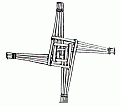 |
St. Brigid's
Cross: St. Brigid fashioned a Cross out of rushes as she sat near a dying
chieftan's bed. He asked her about what she was doing and in explaining,
she recounted the story of Christ, whereupon the chieftan converted. Catholics
-- especially Irish Catholics -- fashion Crosses like these on
the Feast of St. Brigid (1
February). |
 |
Peter's
Cross: because when Peter was to be martyred he chose to be crucified
upside-down out of respect for Christ, the upside-down Latin Cross has become
his symbol and, thereby, a symbol of the papacy. Sadly, this cross has been
co-opted by Satanists whose purpose of "inverting" Christianity (e.g. as
in their Black 'Masses') is expressed by taking the Latin Cross of Christ
and inverting it. At various anti-Catholic Protestant websites, I've seen
pictures of the Holy Father standing in front of Peter's Cross with captions
such as "The Pope worships Satan!!!!!!!" It'd be funny if it weren't so sad
and ignorant. |
 |
Papal
Cross: the three cross-bars represent the Latin Pope's triple role as
Bishop of Rome, Patriarch of West, and successor of Peter, Chief of the
Apostles |
 |
Lorraine
Cross: used by archbishops and patriarchs. Also known as a "Caravaca
Cross" because of a miracle, involving a Patriarch's Cross, that took place
in Caravaca, Spain. See the page on Crucifixes
for more information. |
 |
5-point
Star: the Star of Bethlehem; the 5 Wounds of Christ. This symbol inverted,
such that a single point is at the bottom and two points are at the top,
is a Satanic symbol indicating a goat's head. |
 |
Torch of
Truth: Symbol of the Dominican Order, often shown being carried in the
mouth of a little black and white dog. It originates in a dream St. Dominic's
mother had when she was pregnant with the Saint: she dreamed of her child
as a little black and white dog illuminating the world by carrying a torch
in his mouth. The Dominican Order St. Dominic founded is known as the "Order
of Preachers," the colors of its habit are white and black. |
The Symbology of Numbers
1
|
the Undivided
Oneness of God |
2
|
the two natures
of Christ; both the Divine and the material |
3
|
the Three Persons
of the Most Holy Trinity, the three Magi and their gifts |
4
|
the Evangelists
and their Gospels; the elements, humors and material world; North, South,
East, and West; the four seasons |
5
|
the Five Wounds;
the senses |
6
|
the days of
creation; creation fallen; imperfection |
7
|
covenant, oath;
perfection; the day God rested (the Sabbath being the sign of the Covenant
with Adam); the seven colors the rainbow (a sign of the Covenant made with
Noe); the seven Sacraments (the Covenant sign made with the Church); the
Gifts of the Holy Ghost; the virtues and vices |
8
|
the visible
world, made in seven days, with the invisible kingdom of grace following;
regeneration |
9
|
man's imperfection;
the choirs of Angels |
10
|
the Commandments;
the Plagues of Egypt |
12
|
the tribes
of Israel; the Apostles; the signs of the Zodiac; the hours of the day and
the hours of the night; the penetration of matter with spirit (3 X 4) |
13
|
betrayal;
Judas |
33
|
the number
of years of Jesus's human life |
40
|
testing and
trial; the years of the Deluge; the years of wandering in the desert in Exodus;
the days Moses spent on Mt. Sinai; Christ's days in the desert |
666
|
the number
of the Beast. (Also 616 in some later manuscripts, a number rejected by St.
Irenaeas as a scribal error). |
1000
|
the milennium
-- the Church Age |
 Index Index |
|